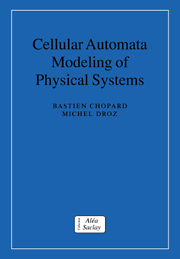4 - Diffusion phenomena
Published online by Cambridge University Press: 26 October 2009
Summary
Introduction
Diffusive phenomena play an important role in many areas of physics, chemistry and biology and still constitute an active field of research. There are many applications involving diffusion for which a particle based model, such as a lattice gas dynamics, could provide a useful approach and efficient numerical simulations.
For instance, processes such as aggregation, formation of a diffusion front, trapping of particles performing a random walk in some specific region of space, or the adsorption of diffusing particles on a substrate are important problems that are difficult to solve with the standard diffusion equation. A microscopic model, based on a cellular automata dynamics, is therefore of clear interest.
Diffusion is also a fundamental ingredient in reaction-diffusion phenomena that will be discussed in detail in the next chapter. Reaction processes such as A + B → C, as well as growth mechanisms are naturally implemented in the framework of a point particle description, often with the help of threshold rules. Consequently, microscopic fluctuations are often relevant at a macroscopic level of observation because they make symmetry breaking possible and are responsible for triggering complex patterns.
Cellular automata particles can be equipped with diffusive and reactive properties, in order to mimic real experiments and model several complex reaction-diffusion-growth processes in the same spirit as a cellular automata fluid simulates fluid flow: these systems are expected to retain the relevant aspects of the microscopic world they are modeling.
- Type
- Chapter
- Information
- Cellular Automata Modeling of Physical Systems , pp. 138 - 177Publisher: Cambridge University PressPrint publication year: 1998



